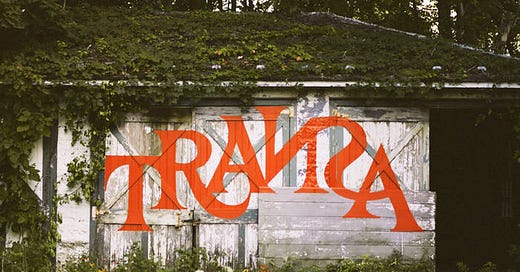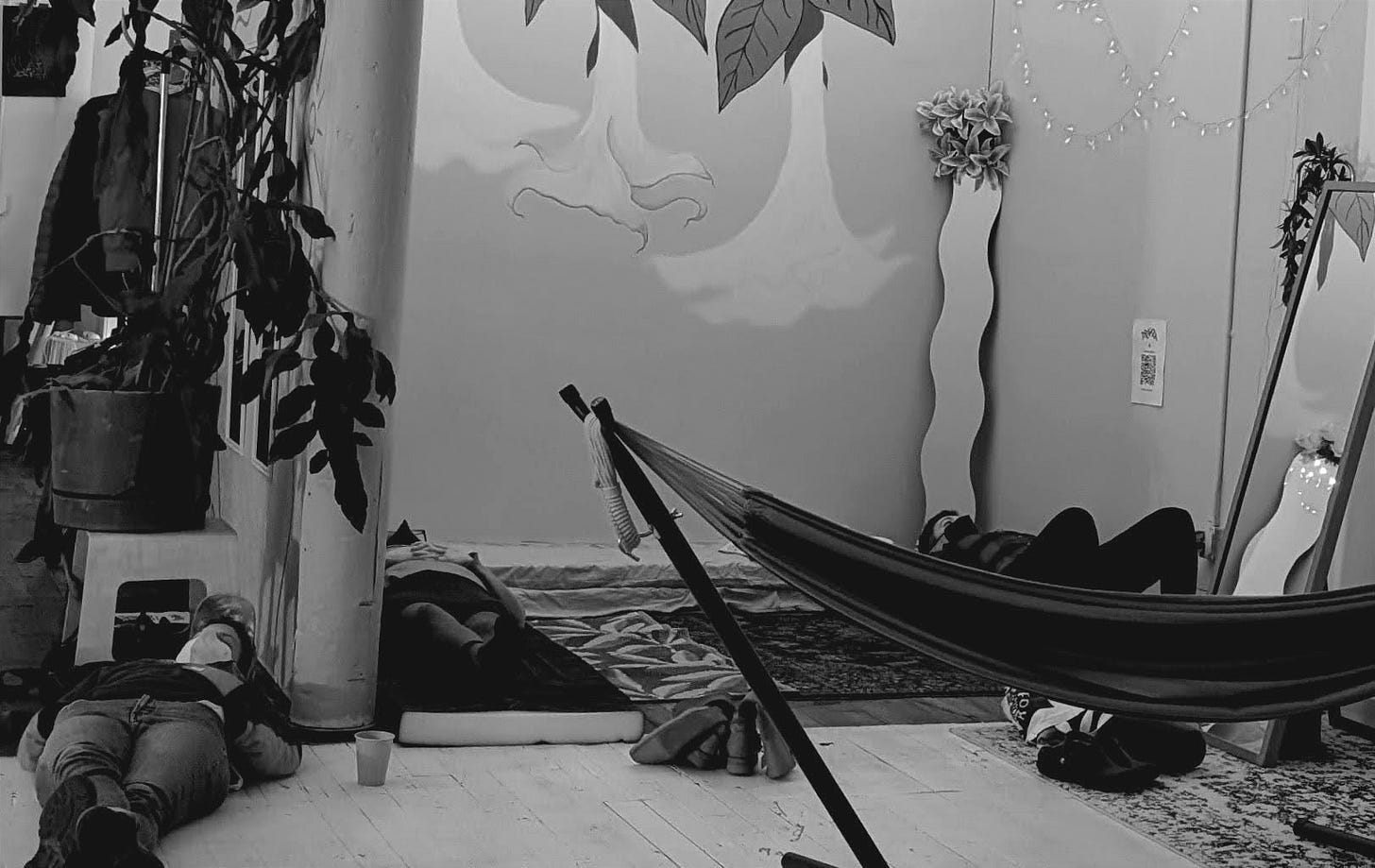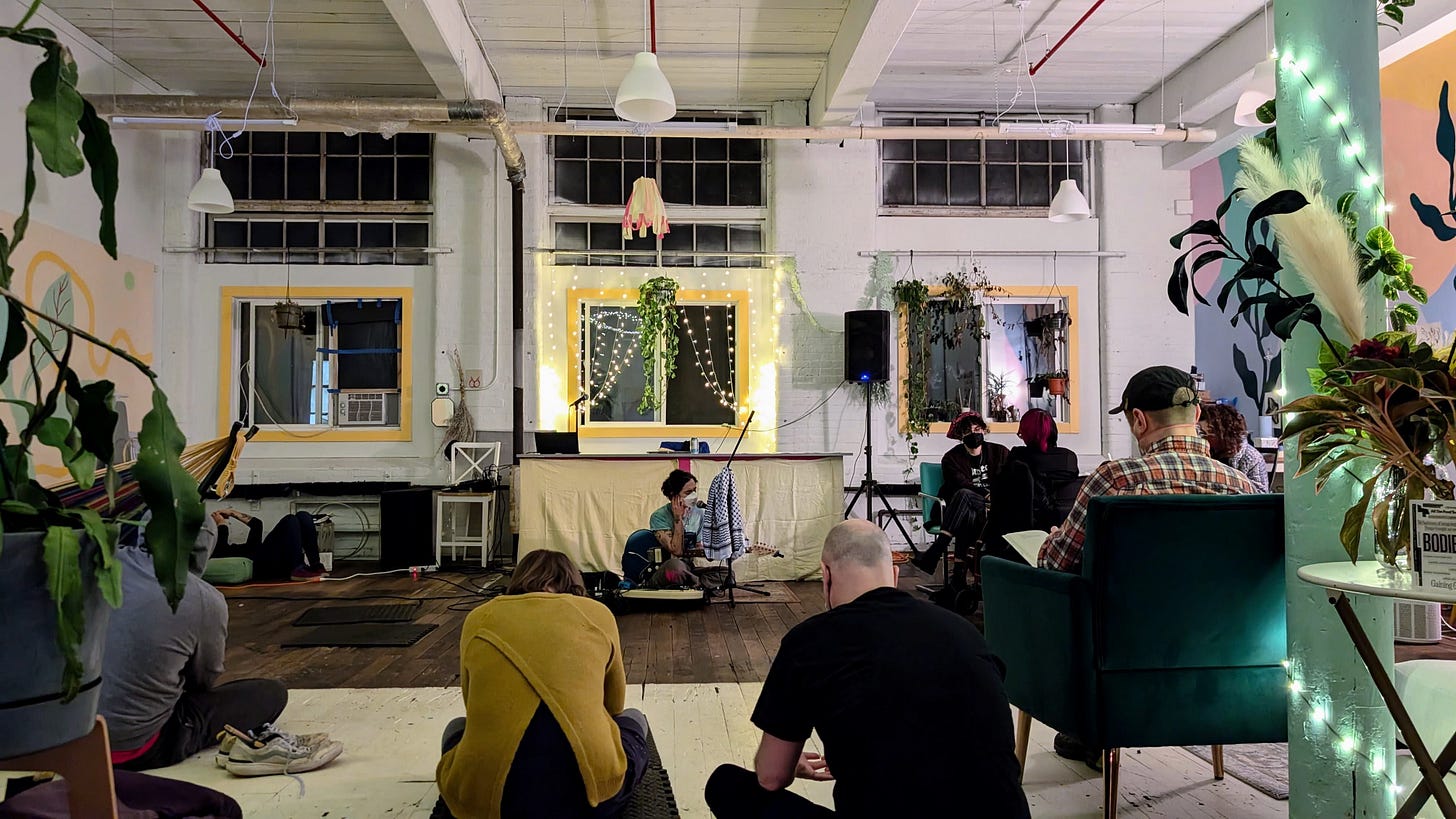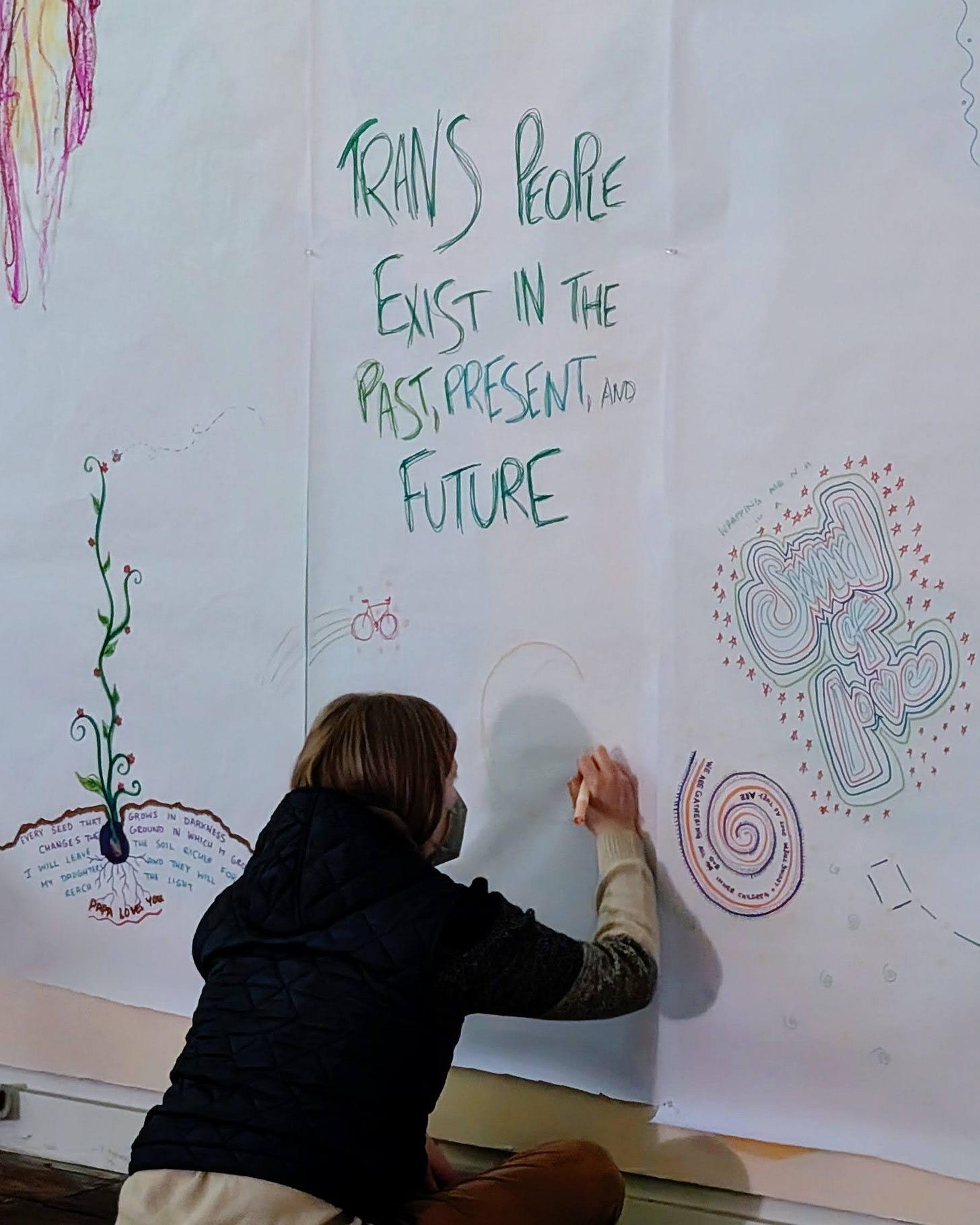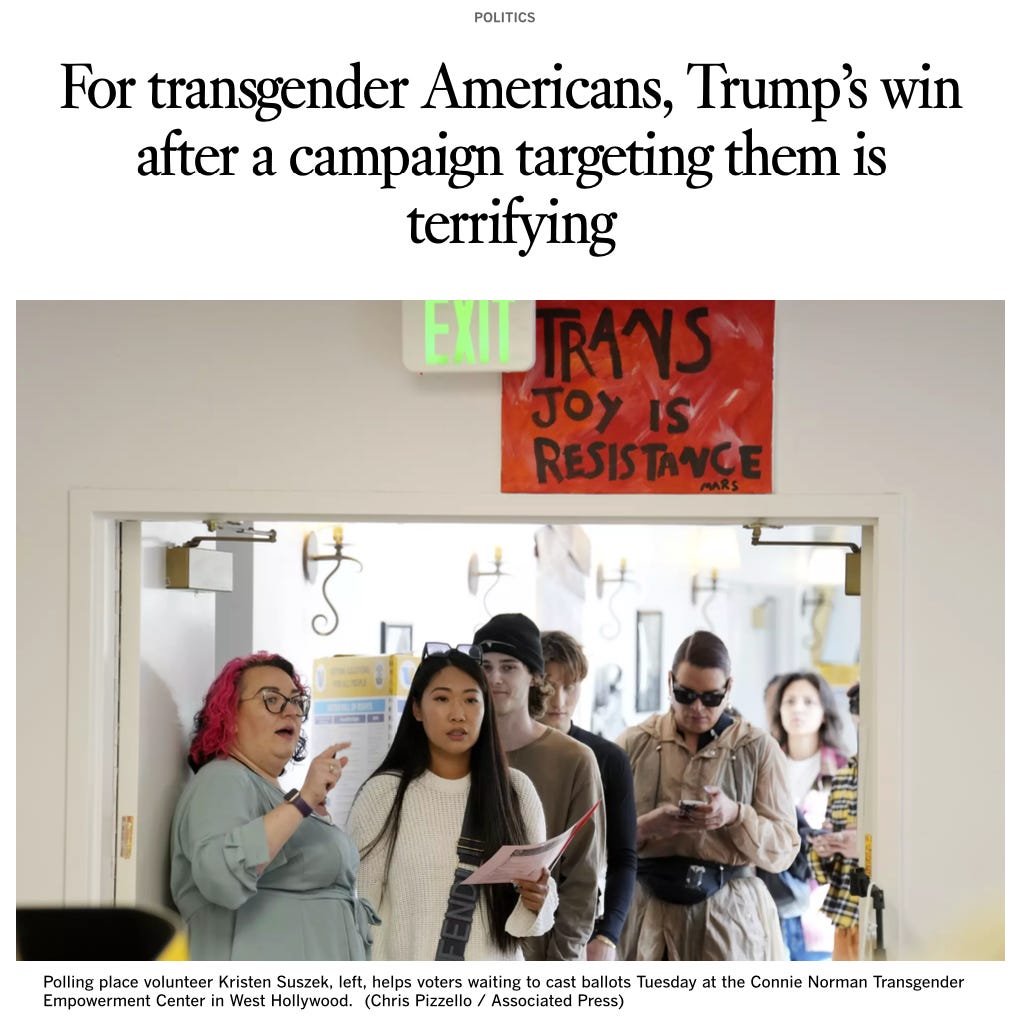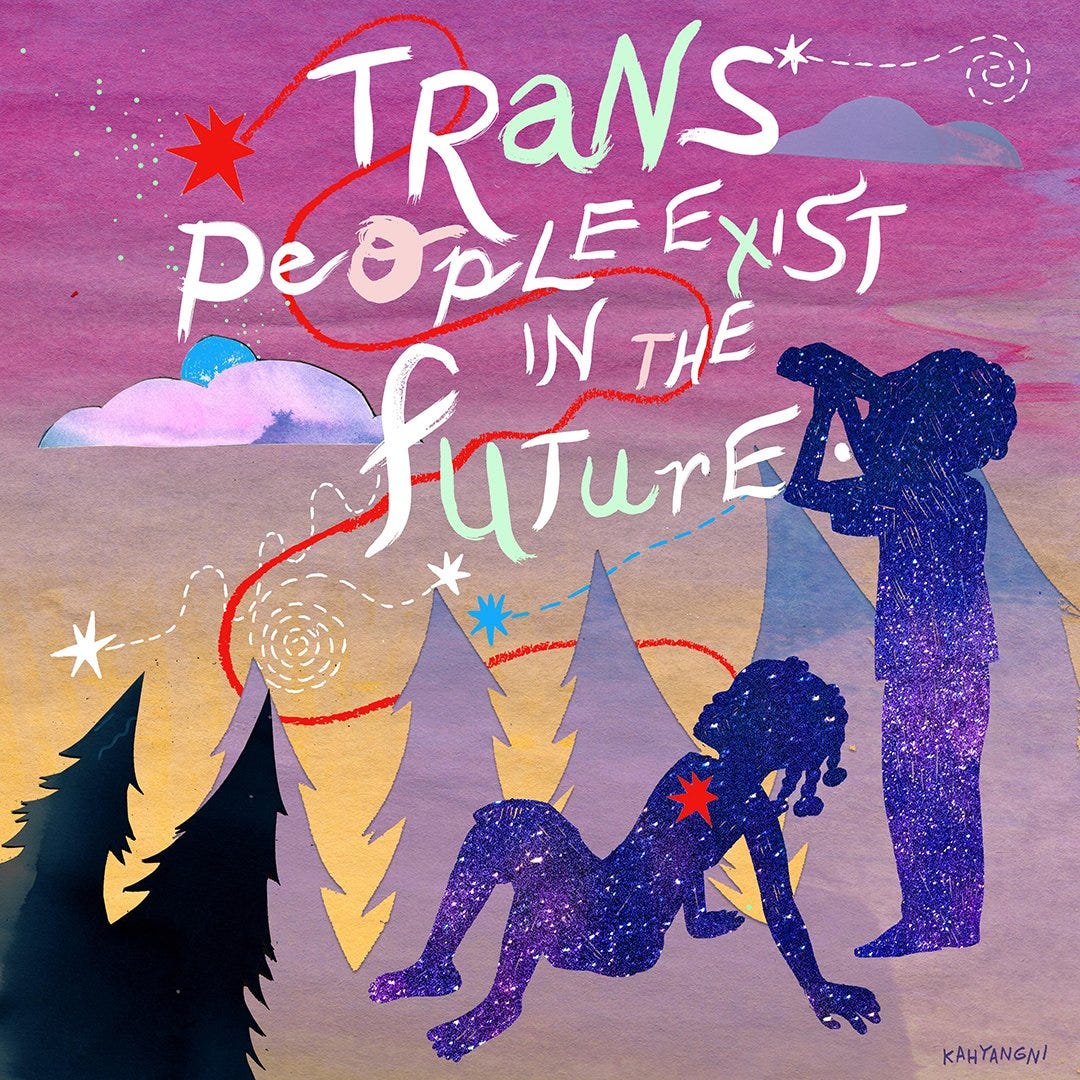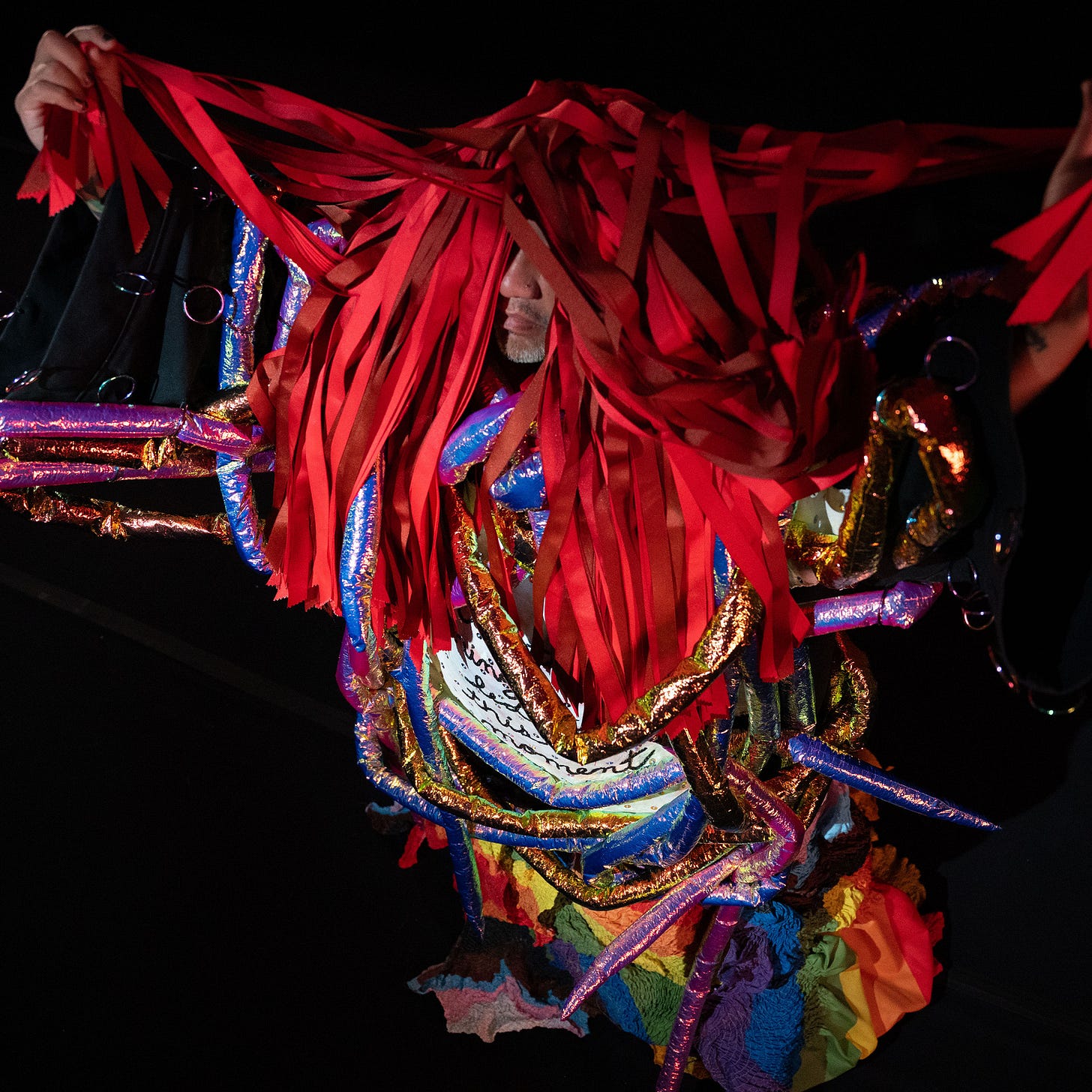The Radical Hope of TRAИƧA
How Collectively Listening to Trans Music Filled Me with Hope that has Survived Trump's Election
On Monday, November 4th, on the eve of the 2024 presidential election, I was in a room of trans people (and non-trans people who love us) listening to more than two hours of selections from the forthcoming compilation TRANSA (set for release on November 22; the full album will be over four hours). This “listening lounge” titled Envisioning and Embodying Trans Futures was the realization of a dream of mine: to gather with community in a trans-run apothecary and art studio, listening to music that honors the multifaceted trans experience and celebrates it as a gift to the world. My vision was borne out of a desire to facilitate a meditation on the power of transness, a grounding in our connection to others, and a commitment to better futures as we moved into election week. I needed to know and share that regardless of the outcome of the election, we were ready for what lay ahead - ready to survive and thrive meaningfully. When the TRANSA project was announced, I knew it would be the perfect conduit for these emotional and relational experiences. Still, I didn’t predict just how transformative the night of the listening lounge would be.
About TRANSA
TRANSA (stylized as TRAИƧA) is a project presented by activist and musical non-profit Red Hot and produced by Massima Bell and Dust Reid. In their words, TRANSA is "a spiritual journey across 8 chapters and 46 songs, spotlighting the gifts of many of the most daring, imaginative trans and nonbinary artists working today. It softens the edges of the world we know, and invokes powerful dreams of the futures that might one day thunder from its cracks." For Massima and Dust, transa means "to love without limits" and "you are more than you know."
The album features collaborations from artists across genres and the spectrums of gender and transness/cisness, from icons and well-known musicians like Sade, Sam Smith, Laura Jane Grace, Moses Sumney, Allison Russell, Perfume Genius, Beverly Glenn-Copeland to more obscure but equally visionary creators. It also includes multiple spoken word poems (by poets such as Eileen Myles, Marsha P. Johnson, and Nsámbu Za Suékama) set to music. Full tracklist and preorder details available here. You can read more about the project/music in coverage in Rolling Stone, Them, and Pitchfork.
The chapters of TRANSA are:
Womb of the Soul
Survival
Dark Night
Awakening
Grief
Acceptance
Liberation
Reinvention
A Brief Introduction to Radical Hope
In recent years, as I’ve worked on the task(s) of supporting trans folks in managing sociopolitical distress, I have repeatedly returned to the idea of radical hope. This is a concept that comes from the work of a collective of BIPOC psychologists1 and their Radical Healing framework for well-being and healing in the aftermath (or alongside) racial and ethnic trauma. I owe a great deal of my approach to trans well-being to the work of BIPOC psychologists and community members who have long been working to document and share the ways that oppressed and marginalized people find meaning and joy. Much of the radical and liberatory psychology theory and practice developed by and for BIPOC folks can be applied or adapted to the needs of trans communities across racial and ethnic backgrounds. This certainly true for the concept of radical hope, which is essential to healing from oppression-based trauma.
Simply put, radical hope is a belief that the future can be different and better for us. It is “radical” in that the belief is anchored in awareness of challenges and oppression. Rather than relying on false hope that denies hardship, radical hope acknowledges ongoing psychological and political harm and, from that context, envisions a future of resistance, purpose, goodness, and possibility. A wonderful (and impressively succinct) paper titled “Radical Hope in Revolting Times” by Dr. Della Mosley and the Radical Healing Collective describes this concept. I highly suggest folks read in full. The paper outlines four pathways to radical hope:
Understanding histories of oppression and resistance
Embracing ancestral pride
Envisioning possibilities
Creating meaning and purpose
The collective briefly describes some components of this in a blog post on radical healing:
Reflect on the ways that your ancestors survived through some of the most difficult times in history (e.g., slavery, colonization, internment camps, detention centers). Your ancestors resisted, persisted.... Their contributions are a testament to the fact that things will be different and better in the future.
I experience the eight chapters of TRANSA as a journey through (among many things) the development of radical hope - and specifically radical hope that trans people can cultivate. Rather than denying our suffering and the oppression we face and engaging exclusively in some flatly positive mantra, there are songs and entire chapters dedicated to sitting in our grief and trauma. Some songs capture the individual experience of this, like Moses Sumney and ANOHNI’s cover of SOPHIE’s “Is It Cold in the Water?”:
I'm freezing
I'm burning
I've left my home
Soft ache, me
Earth shaking
I feel alone
Other songs offer powerful honoring of our trancestors and all they have suffered and survived. The most obvious example of this is L’Rain’s song People Are Small / Rapture.
This track is comprised of covers of two songs by ANOHNI, an award-winning singer, songwriter, and visual artist who has been radically transgressing gender and sexuality norms for decades. ANOHNI herself is deeply reverent of our trans and queer histories. For example, she often performs under the project name ANOHNI and the Johnsons, an homage to late trans activist Marsha P. Johnson. The songs L’Rain covers come from ANOHNI’s work with the Blacklips Performance Cult, a collective of “fellow artists, drag queens, punks, nightlife veterans, and students” who performed weekly plays amid the AIDS crisis in New York City in the early 90s. L’Rain collaborated with the NYC Trans Oral History Project to include excerpts of audio interviews with trans women of color in the song. The clips contain a mix of vitality and sorrow. You’ll hear journalist Imara Jones affirm, “Cities and places - just like people, have memories. And because trans people have been here for such a long time, there’s a memory of us, and there are places and space for us.” While Ceyenne Doroshow reflects sorrowfully on how many loved ones she has lost to AIDS, underground gender-affirming interventions, and violence.
This song leads into “We’ve Been Through So Much,” a stirring introduction to the Grief chapter by composer Jlin and poet Moor Mother.
On Monday night, I lay against pillows on the floor as others around me lay on mats and in hammocks, sat on couches, held each other, flowed through yoga poses, and made art. We listened to these songs and I let the weight of oppression and sorrow fill my body and spirit. I ached for all the suffering I had experienced in my own journey, for what it felt like before I was able to live as a man, for all I know of the suffering of our ancestors, for all I witness in our communities’ ongoing suffering, and for all the suffering in the face of the oppression that we will continue to experience in the foreseeable future. My grieving was both private and shared.
I know from my work as a therapist that the seemingly simple act of experiencing pain alongside another can transform the experience and meaning of that pain. An orienting principle for my work is that suffering is not dangerous, but isolation can make it feel unbearable. Affect feels less overwhelming when shared. Witnessing and sharing suffering create a bearability of the pain.
Music itself is a form of sharing and witnessing; when we listen to music, we meld our emotional experience with the artists’. I realized on Monday that listening - and I mean really listening - to music with others expands that connection significantly. It is not hyperbole to say it was transformative to let myself feel the trauma and grief contained in this music alongside others doing the same. The experience was all the more powerful due to the live ambient music interludes from incredible local trans musician, Bobbie.
Returning to the concept of radical hope, tarrying with histories of suffering also contains acknowledgment of the survival of those who suffered. For example, ANOHNI is represented on this album as both a historical contributor/inspiration and as a contemporary creator of new music - I had actually just seen her perform the previous Saturday. And there is even survival in the stories of suffering of the trancestors we’ve lost, because we are here. We are a part of their legacies; they endure through us. Trans people exist in the past, present, and future. Transness survives.
The journey of TRANSA does not stop with grief and survival, though. As the night progressed, we moved into the chapters of Acceptance and Liberation. Anchored in the power of acknowledging our suffering and survival, we listened collectively to music celebrating trans people’s self-actualization, resistance, empowerment, and freedom.
I want to acknowledge here the uniqueness of a project this big that celebrates trans people and transness - that centers our communities’ contributions to the world and positions us as teachers, healers, and guides. Think about the slogans common in trans-related activism: “protect trans kids/people,” “Black trans lives matter,” “trans people belong,” “trans rights are human rights.” With perhaps the exception of #transisbeautiful, so much of trans content is oriented around defending our humanity and ensuring we are welcome and safe. One of the messages of the TRANSA project is essentially an authentic and strong “Thank you, trans people.” Also: “trans people are awesome” and “aren’t we all lucky and better for the existence of trans people?” The fact that the songs are collaborations between over 100 trans and non-trans artists makes these messages particularly meaningful to me: a reminder that my transness and the transness of the people around me are gifts, and that many people recognize that.
Allison Russell and Ahya Simone’s cover of Jackie Shane’s soul classic “Any Other Way” epitomizes this. First of all, Ahya Simone is a beautiful harpist who is also a Black trans woman and her contributions on this song really take it to the next level. Second, Jackie Shane herself is an example of trans people’s presence and artistic generativity throughout history. Born in 1940 in the Jim Crow-era south, Jackie’s female gender was accepted by her mother at an early age. She had a successful career in Toronto as a soul singer in the 1960s - the original version of this song reached #2 on the Canadian charts in 1963. She did not hide her identity as a woman, though without the language and awareness of transness she was sometimes described by others as gender-nonconforming and/or in drag. In the context of Jackie Shane’s life history and the location of the track in TRANSA’s Acceptance chapter, the song’s lyrics become a defiant and proud declaration of self-affirmation, even alongside struggles and strife. I can’t wait for everyone to hear this.
“Tell her I wouldn't have it / any other way”
Again, listening to songs from the album privately has been moving in and of itself, but sharing this experience with community, amid embodied reckoning with our suffering and oppression and survival amplified the experience exponentially. On Monday night, listening to TRANSA with others, I knew the beauty and power of transness so deeply that it felt like altered consciousness. At one point, a friend whispered to me, “this is sort of a psychedelic experience, isn’t it?”
The night concluded with the final chapter of TRANSA: Reinvention, which celebrates the truth that when fully conscious, we find ourselves in constant transformation. We are empowered and connected to both other people and to the larger natural world by rooting into our ever-evolving nature. The closing song is a new version of Beverly Glenn-Copeland’s 1986 song Ever New, which Glenn collaborated on with Sam Smith. It is a quintessential example of the celebration of constant change both lyrically and through the act of reimagining the song across generations (Glenn is an 81-year-old trans man and musician spanning many genres and Sam Smith is a 32-year-old nonbinary pop star).
This valuing of constant transformation is crucial in the current political climate and critical to the development of radical hope among trans people. Narratives of transness, particularly those considered more palatable, are often incomplete, falsely framing transition as tidy line from one clearly defined point in time/space/gender to another. The acronyms MTF/m2f and FTM/f2m reinforce this. Trans people have often been discouraged from sharing the ways in which transness is messier than this, and typically made to feel that this messiness is wrong and disruptive in unwanted ways. In reality, this messiness and fluidity are disruptive in needed and desirable ways, because they highlight the true and inherent nature of self/gender/world: the only constant is change. Trans people who revel in and share their dynamic understandings of themselves and dynamic ways of relating to the world have the potential to wake society up from our fixation on false constancy. We shouldn’t be tasked with resisting or hiding this part of our journeys. Not to get too lofty, but I really believe this is one of the ways in which our very existence as trans people is resistance to fascist and authoritarian states - ideologies that rely on rigid definitions because they seek to enforce a singular, unquestioned order. A world that celebrates fluidity, complexity, and transformation resists the simplicity and control that authoritarianism depends on.
In terms of radical hope, Reinvention in particular represents the better futures I want to invest in dreaming up together: futures where we are all fully connected to our dynamic natures and the world(s) around us. According to the Radical Healing Collective, envisioning possibilities of far-reaching change is one of the necessary pathways to radical hope. At the TRANSA celebration at Performance Space New York in September, I was struck by something Massima Bell said, which I will paraphrase to the best of my memory: “We know that one day, the earth will reclaim this city, and forests will return across what was once known as Manhatta. This may be millenia in the future. And in this green world of the future, it is our hope that the songs of TRANSA will exist, or perhaps something that they inspired or made possible will be heard.”
I had never thought about hope for the future being so long. The idea that what we were co-creating in that space would make ripples that extend so far into the future was both calming and invigorating.
Taking in TRANSA with my community (including community members I’d never met before, to be clear) on Monday helped me believe in our collective presence and power, both in the near and the super-distant future. I could envision sweeping transformation stemming from the actions (even the small ones) we are taking now. The journey through the chapters - from naive possibility and openness to trauma, survival, awakening, and grief to acceptance and liberation to reinvention - grounded my visions of future survival and thriving in the struggles we have already endured individually, collectively, and historically. Experiencing this powerful and gorgeous and fun music was an embodied and moving reminder of all that trans people bring to each other and the world at large. Doing all this in community affirmed that I am not and we are not alone.
On the morning of Wednesday, November 6th, my partner and I woke to the news Trump’s re-election.
We have been deeply fearful of and unsettled by this potential outcome, though we somewhat anticipated it, it was still devastating. My partner cried. I felt sick. I believe a Trump/Vance presidency and an emboldened MAGA faction will bring increased suffering to the trans community and to countless other marginalized communities and groups. Frankly, I believe the negative of impacts of this administration and the growing fascist movement will extend beyond the marginalized. And I expect the consequences to last far beyond a single term.
But amid the sorrow and horror and dread, I also felt empowered and yes - hopeful. After Monday night’s embodied envisioning of trans futures through TRANSA, community, and art, I developed faith in our individual and collective capacities to withstand what is coming and shape our futures. These feelings and beliefs have persisted. I feel a calm resolve2 extending from this practice of radical hope.
I recently had the meaningful experience of talking with high school students about the concept of radical hope. During that discussion, my friend (their teacher) said, “It’s not so much a belief that things are going to be okay - at least in the short-term, but that we are going to be okay.” And that’s exactly what I’m feeling. Things may not be okay, but we will be okay.
There are more listening events happening in the coming weeks. Check out socials or sign up for the TRANSA newsletter to see if there is one near you. If there isn’t, I strongly suggest gathering a group of people together and listening to it once it’s released on November 22.
You’ve reached the conclusion of the main part of this post. Below you’ll find suggestions for cultivating radical hope, because I want other folks to have access to what I have felt this week.
Suggestions for Cultivating Radical Hope
I want to create more opportunities to adapt Radical Hope and other principles of Radical Healing for my communities. I’ve started Trans Futures Western Mass to continue to organize collaborative events in this spirit. And here are some suggestions of concrete things trans folks can do to build radical hope in your life and communities:
Learn trans history, particularly history that is written by trans people and takes an intersectional lens (in other words, work that centers how other histories of oppression have shaped trans history). Some suggestions for books and movies off the top of my head - feel free to share more in the comments:
Listen to trans music and take in trans art. Obviously, TRANSA is a strong recommendation from me and will be out soon. Here are some other suggestions:
TRANSA: Selects, a collection of five advance release songs is already out. Listen here or on any streaming platform.
Beverly Glenn-Copeland is a trans elder and musical genius who has released multiple albums across the decades. He is featured on TRANSA multiple times, but I recommend digging into his discography.
This summer I made a playlist of 41 songs I enjoy from trans musicians. Perhaps not surprisingly, this list includes many of the musicians featured on TRANSA, though through TRANSA I’ve learned of way more trans people creating great music.
Be on the lookout for trans art exhibits, installations, or online accounts. For example, queer and indigenous visual artist Jeffrey Gibson just opened a huge installation at Mass MoCA called Power Full Because We’re Different, a meditation on and celebration of experiences of two-spiritness. It will be open until May 2026 and there will be performances in the space throughout the coming months. PDF to the exhibit guide for that installation is here. Another source of awesome trans art is the Trans Day of Resilience project, which includes annual releases of TPOC-created visual art and poetry:
Make art! Design prompts to inspire visual art, poetry, or music that envisions possibilities of future survival and/or great societal change. One of the great things about our event was that we had trans artists facilitating collaging and collective wall art that centered around the chapters of TRANSA and the experience of listening to the album. Art is a wonderful way to escape the limitations of our cognitive brain and really dream.
Connect with community members about individual and collective strengths. One example is that my partner and I have been getting together with neighbors and friends and asking folks to share what skills or traits they bring to their communities. This can be empowering in terms of envisioning a resilient future through collectivism.
e.g., “I am good at connecting with people,” “I can cook batch meals,” “I have financial resources to share,” “I’m a bike mechanic,” “I can sew,” “I make people laugh,” “I have chickens who lay eggs,” etc.
Build skills and acquire goods where you recognize gaps in your community. This again bolsters your sense of feeling and being capable in uncertain or difficult futures.
e.g., learn how to fix a car, invest in alternative power supplies, read about DIY hormones, plant a vegetable garden and pollinator plants, etc.
Go to trans or queer-centered events in your local or nearby communities, even if this pushes you out of your comfort zone. Our orientation to the collective is critical to radical hope and that means being and feeling connected to others. If you’re on social media, follow local queer and trans accounts to stay updated on events and groups. If you don’t see them happening in your area, consider organizing some. I am not an event planner naturally. In order to plan and throw this event I had to learn a lot, move outside my comfort zone, and collaborate with others. But smaller scale stuff can be as simple as identifying something you like to do (say, a board game or riding bikes), picking a time and space to do it, and letting folks know about. Even better if you can incorporate accessibility to wide ranging groups (e.g., consider transportation needs and host near a bus line), but starting anywhere is great.
Join online communities especially if your access to in person community is limited. There are suggestions online of how to find different communities (e.g., on reddit, discord). Here is one list and here’s a collection of trans community resources from Trans Lifeline.
Don’t avoid your hurt and fear. Remember that acknowledgment of pain and oppression are critical in separating useful radical hope from unhelpful wishful thinking. Do not deny your pain and other feelings but explore them and sit with them to move through them. Music and art (both taking it in and creating it) are powerful tools in this.
Don’t fear hopelessness. Seven years ago, in an interview about her album Hopelessness, ANOHNI said, “It’s been important for me to realize that hopelessness is a feeling; it’s not a fact, and it actually has very little bearing on what’s to come.” Letting yourself feel hopeless from time to time, knowing that it doesn’t mean you don’t have reason to hope and doesn’t even mean that you don’t ultimately have hope, is critical to moving through it and developing authentic and energizing experiences of radical hope. Often hopelessness is a signal of fatigue and sadness and can be a message that you need to grieve, rest, and do something restorative.
Specifically, Drs. Helen A. Neville, Hector Y. Adames, Nayeli Y. Chavez-Dueñas, Grace A. Chen, Bryana H. French, Jioni A. Lewis, and Della V. Mosley
I’ve borrowed this term from my mother whose substack Calm Resolve includes reflections on her experiences of and lessons from living with Stage IV cancer.

